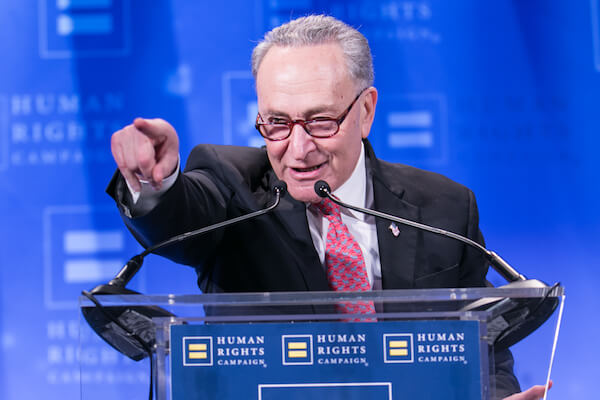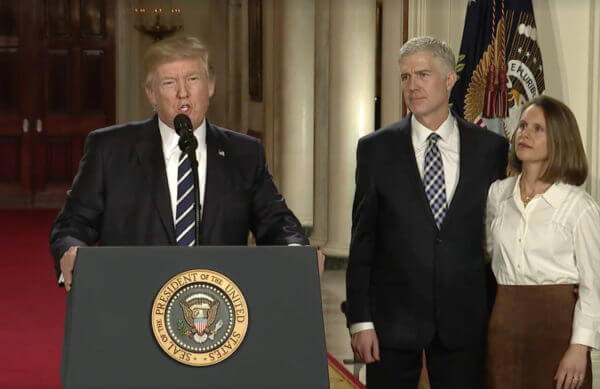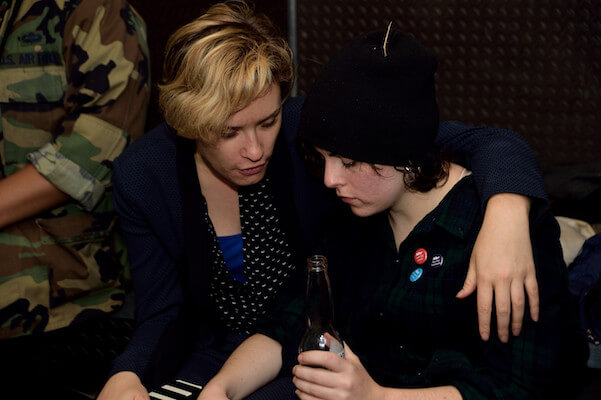ILLUSTRATION BY MICHAEL SHIREY
With the Hawaii State Senate giving final approval to a marriage equality bill on November 12, gay and lesbian couples in a total of 16 states plus the District of Columbia have now won the right to marry.
Those states account for 37 percent of the nation’s population.
Advocates working to expand the map –– to include the remaining 34 states and 63 percent of the population –– are buoyed by the progress, but caution that the current pace of gains that saw victory in seven states this year alone will not continue in the short term. Much of the hard work remains and will require considerable effort, resources, and patience.
When same-sex weddings began in Massachusetts in May 2004, just over two percent of the nation’s population lived in marriage equality jurisdictions. Until 2007, a 1913 law –– a relic of an era when Massachusetts chose to honor statutes elsewhere barring interracial marriage –– kept same-sex couples from states without the right to marry from getting a license in the Bay State.
After New York, in July 2011, became the sixth state to allow same-sex couples to marry, only 11 percent of the nation’s population lived in marriage equality jurisdictions, a figure that grew to just 16 percent after successful referendum battles in Maine, Maryland, and Washington State in last November’s election.
The rush to the altar accelerated dramatically this year. By the end of May, gay marriage had been approved legislatively in Rhode Island, Delaware, and Minnesota, and in June the US Supreme Court let stand a lower court ruling that threw out California’s Proposition 8, a voter initiative that halted same-sex weddings there in 2008, just months after that state’s highest court authorized them.
Then, in the first of a rapid series of victories over the past month, New Jersey’s Republican governor, Chris Christie, threw in the towel on blocking gay marriage. He did so when it became clear the State Supreme Court would, in January, uphold a lower court decision finding that –– in the wake of the collapse of the Defense of Marriage Act’s ban on federal recognition –– the state’s civil union law failed to provide same-sex couples with the same rights and benefits as married couples.
Last week, the State House of Representatives in Illinois approved a bill the Senate had passed in February and the Hawaii House adopted an amended version of a measure approved earlier by that state’s Senate. Democratic Governor Neil Abercrombie is expected to sign the Hawaii measure quickly now that the Senate has approved the House amendments, allowing marriages to begin on December 2. In Illinois, Democratic Governor Pat Quinn will sign the gay marriage law on November 20, though weddings there will have to await a July 1, 2014 effective date, unless the Legislature acts in January to move that date up.
 Just as the percentage of Americans living in gay marriage jurisdictions has grown dramatically, so too has support for granting gay and lesbian couples full equality. When the first couples married in Massachusetts, only about a third of Americans were in favor of marriage equality, according to a statistical analysis Nate Silver published in March on his fivethirtyeight blog at the New York Times. He estimated that figure rose to 51 percent by the spring of 2013. By then, the Human Rights Campaign was pointing to an ABC/ Washington Post poll that put support at 58 percent –– and as the year has gone on, other polls have been closer to that level than Silver’s figure. According to a Pew Research Center poll in May, 70 percent of Americans born after 1980 favor the right of same-sex couples to marry.
Just as the percentage of Americans living in gay marriage jurisdictions has grown dramatically, so too has support for granting gay and lesbian couples full equality. When the first couples married in Massachusetts, only about a third of Americans were in favor of marriage equality, according to a statistical analysis Nate Silver published in March on his fivethirtyeight blog at the New York Times. He estimated that figure rose to 51 percent by the spring of 2013. By then, the Human Rights Campaign was pointing to an ABC/ Washington Post poll that put support at 58 percent –– and as the year has gone on, other polls have been closer to that level than Silver’s figure. According to a Pew Research Center poll in May, 70 percent of Americans born after 1980 favor the right of same-sex couples to marry.
Momentum is clearly on the side of marriage equality. But 34 states do not grant gay couples the right to marry, and the opportunities available in many of the existing marriage equality states –– legal, legislative, and political –– are not currently options in the bulk of the remaining ones.
“We’re in the midst of amazing progress but the road’s going to get a little tougher now,” said James Esseks, director of the LGBT and AIDS Project at the American Civil Liberties Union (ACLU).
Marc Solomon, national campaign director at Freedom to Marry, made much the same point, saying, “We have reached a gap where we’re out of the phase of winning one state every few weeks.”
The current hurdles in the way of further progress are largely the result of states having rushed over the past two decades to bar marriage by same-sex couples. After conservatives in Congress, alarmed by preliminary progress marriage equality was making in Hawaii in the mid-1990s, succeeded in getting the federal Defense of Marriage Act enacted, many states followed suit –– not only by statute but also through constitutional amendments, many of which barred both gay marriage and other types of same-sex relationship recognition as well.
 Of the 34 states without gay marriage, only Pennsylvania, West Virginia, Indiana, Wyoming, and New Mexico are without such constitutional prohibitions. The current prospects for enacting gay marriage in any those states –– the route to victory in 12 existing marriage equality jurisdictions (11 states and the District of Columbia) –– are not favorable, according to Solomon, who hastened to add that Pennsylvania, which is immediately adjacent to the swath of 11 Eastern Seaboard jurisdictions where marriage is legal, remains a prime target in the intermediate term.
Of the 34 states without gay marriage, only Pennsylvania, West Virginia, Indiana, Wyoming, and New Mexico are without such constitutional prohibitions. The current prospects for enacting gay marriage in any those states –– the route to victory in 12 existing marriage equality jurisdictions (11 states and the District of Columbia) –– are not favorable, according to Solomon, who hastened to add that Pennsylvania, which is immediately adjacent to the swath of 11 Eastern Seaboard jurisdictions where marriage is legal, remains a prime target in the intermediate term.
State court action –– which was the path to success in Massachusetts, Connecticut, California (initially), and Iowa –– is another possibility in those five states, and a remarkable case unfolding in New Mexico could yield that result in the near future. There, the ACLU and the National Center for Lesbian Rights (NCLR) filed suit on behalf of six same-sex couples. The litigants succeeded in getting an emergency order allowing plaintiffs Jennifer and Angelique Neuman-Roper to marry before Jen’s terminal brain cancer took her life. Several days later, the judge in the case broadened that order to allow marriage licenses to be issued generally in the state’s two biggest counties.
The State Supreme Court heard oral arguments in the suit on October 23, and at least some attorneys involved in the case expect a decision fairly soon.
Tragically, Jennifer Neuman-Roper, who was able to marry Angelique, died on November 8.
Outside of the five non-marriage states without constitutional prohibitions, the path ahead is more difficult and relies on approaches avoided in the early years of the marriage equality movement –– popular referendums and federal court action.
Prior to the 2012 general election, the LGBT community lost more than 30 ballot fights when gay marriage was at issue, winning only in 2006 when an Arizona proposal was so far-reaching that it would have been banned, for example, domestic partnerships for opposite-sex senior citizens who met late in life after the death of spouses with whom they had completed their estate planning. The defeats included the rollback of marriage in California in Prop 8 and the veto of a marriage equality statute enacted by the Legislature in Maine the following year.
Many LGBT activists argued that civil rights should not be put up for a vote, and that was a key rationale Garden State Equality articulated in continuing to litigate the issue in state court and seek an override of Governor Christie’s 2012 veto, rather than accept his challenge to take the issue to the voters.
Last November’s election changed the ballgame on referendums, however. On one day, voters approved marriage equality laws enacted legislatively earlier in the year in Maryland and Washington State, affirmatively approved gay marriage in Maine (three years after rejecting the Legislature’s gay marriage measure), and turned back a constitutional ban in Minnesota (which just months later enacted its own gay marriage law).
Suddenly, the idea the community could win at the battle box was proven a viable option. It may now be the most predictable route to advancement.
“Would we prefer not going to the ballot?,” Freedom to Marry’s Solomon asked. “Yes, but it’s the way to win. Until we get a federal court ruling in our favor, it may be the only way to win in many places.”
For Solomon and other leading advocates in the fight, including the ACLU, the next ballot box battleground is Oregon, where his group points to polling from last December showing pro-equality support at 54 percent. The state is a logical target for other reasons, as well. Bordered on the north by Washington and the south by California, Oregon implemented a civil union-style law in 2007 and, just last month, began honoring same-sex marriages from other jurisdictions based on an opinion from the state’s Department of Justice.
Solomon, the ACLU’s Esseks, and other advocates also agreed on the other top targets for voter referendums –– Colorado, Nevada, Arizona, Michigan, and Ohio. The ballot effort in those states, however, would not be undertaken until 2016.
Defensive referendums still provoke anxiety among gay marriage advocates, who are fighting to forestall a constitutional amendment vote next year in Indiana and to block any effort by legislators in New Mexico to overturn a potential state court victory there.
Since legislatures cannot enact laws to get around constitutional amendments and it is also difficult to challenge them in state courts, the other key avenue for expanding the map is through federal litigation. When the American Foundation for Equal Rights, a newly formed group, announced in 2009 that it was mounting a federal court challenge to Prop 8, leading LGBT legal advocacy groups reacted with dismay –– worried that, with the current Supreme Court composition, there was a distinct risk of locking in a bad ruling. By the time the high court this June allowed a district court decision striking down the voter initiative to stand, views had changed considerably. And AFER’s founder, Chad Griffin, was sitting at the helm of the Human Rights Campaign, the nation’s leading LGBT lobby group.
Though it restored gay marriage to California, the Prop 8 case in and of itself did not indicate where the Supreme Court stands on the question of a constitutional right for same-sex couples to marry –– except, perhaps, that it is not yet ready to decide. District Judge Vaughn Walker issued a sweeping ruling in AFER’s favor identifying such a right, but the Ninth Circuit Court of Appeals affirmed him on narrower grounds, finding that the constitutional problem lay in the voters’ decision to take away a right gay Californians previously enjoyed as a result of a ruling from that state’s Supreme Court. On technical grounds, the US Supreme Court voided the appellate ruling and let stand Walker’s decision –– without establishing any precedent on the underlying issue.
Still, given the opinions written by Walker and by federal courts in a variety of cases that led to this June’s win over DOMA at the Supreme Court, legal advocates have become emboldened about the issue being winnable for keeps at the nation’s highest court.
Several dozen cases challenging state marriage bans –– brought by the leading LGBT litigation firms and, in some cases, by private attorneys alone –– are now working their way through the federal courts, with no certainty as to which might move most quickly, either in winning marriage in a particular state or in getting the broader issue before the Supreme Court.
One of them, a lawsuit by Lambda Legal, involves Nevada, which has both a constitutional amendment barring gay marriage and a broad domestic partnership law analogous to a civil union statute. Lambda’s original filing in the case focused on the argument that Nevada could not give couples all the rights and benefits of marriage but deny their unions the label of marriage, a perspective in line with the logic of the Ninth Circuit ruling in the Prop 8 case, which emphasized that California’s domestic partnership law did just that.
Lambda lost at the district court level, but that ruling addressed the broader question of a constitutional right to marriage, an issue that Lambda has expanded on in its pending appeal to the Ninth Circuit. Because the case is already in the appellate phase, it has the potential to be the first of the new round of federal challenges to make it to the high court, though the ACLU’s Esseks noted that the Ninth Circuit is historically the slowest to act. It could also be that a victory in Nevada would be narrowly tailored to states that give same-sex couples broad domestic partnership benefits, but not marriage, a group that also includes Colorado and Oregon.
Most of the other federal marriage suits do not fit the specific fact pattern of Nevada, California, Colorado, and Oregon, and may therefore pose the fundamental question more directly. Lambda has filed suit regarding West Virginia, and in tandem with the ACLU regarding Virginia, whose marriage ban is also being challenged by AFER. The ACLU is also active in litigation over North Carolina’s constitutional ban on gay marriage and Pennsylvania’s statutory ban. The NCLR has recently filed new suits regarding Idaho and Tennessee in federal court.
In Michigan, a federal lawsuit by a lesbian couple, April DeBoer and Jayne Rowse, challenging the state’s ban on joint adoption, was amended at the suggestion of the judge to include a challenge to that state’s marriage ban. Michigan’s motion for summary judgment was denied, with the judge, Bernard Friedman, finding that the Supreme Court’s June decision in the DOMA case strengthened the “plausibility” of the couple’s claims. That case goes to trial in February, and the couple is represented by private counsel, though with the amicus support of the ACLU of Michigan.
In Ohio, a federal district court judge ruled that a Cincinnati couple who married in Maryland, James Obergefell and John Arthur, were entitled to a temporary restraining order requiring the local registrar of death certificates to record them as married when Arthur, who was critically ill with Lou Gehrig’s disease and has since died, were to pass away. That order was later expanded to include another Ohio gay spouse who died, and the judge has now allowed a gay funeral director in Cincinnati to carry on the case as a “third-party plaintiff” eligible to assert a claim on behalf of future clients.
In issuing his original restraining order, the judge, Timothy S. Black, cited Edie Windsor’s victory over DOMA, finding that Ohio may well be violating a same-sex married couple’s equal protection rights when treating them differently than other married couples. He also noted, “Ohio law has historically and unambiguously provided that the validity of a marriage is determined by whether it complies with the law of the jurisdiction where it was celebrated.” The Ohio case –– being argued by Alphonse Adam Gerhardstein, a prominent gay right litigator in the state –– is focused on out-of-state recognition, but clearly Black’s reliance on the DOMA equal protection finding has broader implications.
No leading advocate will get into the business of predicting how judges will rule, but the ACLU’s Esseks and Freedom to Marry’s Solomon agree that as cases move through the courts –– state benches in New Mexico and elsewhere and in numerous federal districts –– the work of advocates at all levels is additive. Public education, underway everywhere but especially in those states where referendums are likely –– both proactive and defensive –– could pay off not only at the ballot box but also in the national conversation.
And the national mood –– coupled with the metrics of marriage equality’s advance –– will likely play a critical role if and when the Supreme Court takes up the constitutional question directly.
After making an obligatory nod to the importance of legal argumentation, Esseks said of the high court, “They, like the rest of us, live in the real world… We will want to answer the questions of where is public opinion? How many marriage equality states are there? What percentage of the population lives in those states? We want them to see a country that is ready to embrace this.
Solomon noted two historical examples regarding the Supreme Court –– the 1967 Loving ruling that struck down the nation’s remaining laws barring interracial marriage and the 2003 Lawrence ruling that eliminated sodomy laws. In the 19 years after the California Supreme Court threw out that state’s miscegenation law, just under half of the 30 states with similar statutes did away with theirs. The high court upheld Georgia’s sodomy statute in 1986, when 24 states still had similar laws. By 2003 –– the year of the Lawrence ruling reversing the 1986 decision –– another 10 states and the District of Columbia had followed a pattern begun by Illinois in 1962 in jettisoning such statutes.
Freedom to Marry’s game plan is predicated on achieving, by 2016, public support for marriage equality nationwide above 60 percent and more than half of the nation’s population living in states that give same-sex couples the right to marry.
“We really do think that the court will see that the nation is ready,” he explained.
Esseks acknowledged the efforts underway are also necessary in the event the litigation route proves to be a dead end.
“The work we do in the states is to prepare for the Supreme Court or, if we lose in the Supreme Court, to do the longer slog that would follow,” he said.



































